The Economics and Statistics Division maintains archives of previous publications for accountability purposes, but makes no updates to keep these documents current with the latest data revisions from Statistics Canada. As a result, information in older documents may not be accurate. Please exercise caution when referring to older documents. For the latest information and historical data, please contact the individual listed to the right.
<--- Return to Archive
For additional information relating to this article, please contact:
November 29, 2019CANADIAN ECONOMIC ACCOUNTS Q3 2019 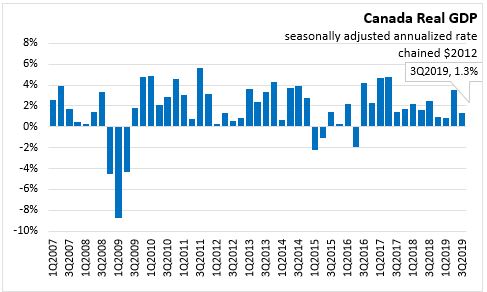
Real gross domestic product (GDP) grew 1.3 per cent (all figures seasonally adjusted at annual rates) in Canada in the third quarter, following growth of 3.5 per cent in the second quarter and 0.8 per cent in the first quarter of 2019. Final domestic demand was up 3.2 per cent in the third quarter led by higher business investment, residential investment and household spending while government final consumption expenditures growth slowed.
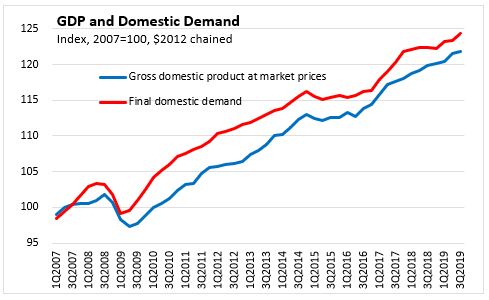
Growth in household final consumption rose 1.6 per cent in Q3 2019 following growth of 0.5 per cent in the second quarter. Durable goods rebounded after a decline the previous quarter. led by purchases of new trucks, vans and SUVs. Semi-durable (+1.9%) and non-durable (+1.2%) purchases were also up. Growth in service expenditures accelerated to a 1.6 per cent pace after only 0.8 per cent in Q2.
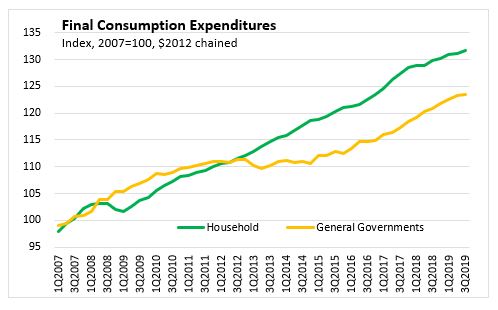
Business investment was up 10.7 per cent in Q3 do it's fastest pace since 2017 Q4. Growth was up in non-residential buildings and engineering structures. Machinery and equipment was up 7.0 per cent and intellectual property products rose 6.0 per cent.
Housing investment rose 13.3 per cent, the fastest pace since first quarter of 2012. New construction of single-detached homes in Ontario and higher resale activity in British Columbia and Ontario drove the increase.
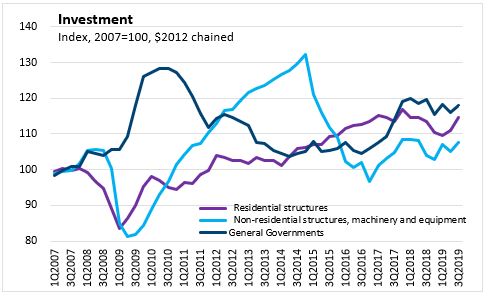
Export volumes declined 1.5 per cent after a 12.9 per cent increase the previous quarter. Lower exports were notable in non-metallic minerals, and farm and fishing products. Exports of services was essentially unchanged. Import volumes were flat in Q3 after declining last quarter. Increased imports of chemical products, pharmaceuticals were offset by declines in motor vehicles and industrial machinery and equipment.

Inventories accumulation declined from $12.8 billion in Q2 to $4.2 billion in Q3. Cannabis inventories contributed $4.9 billion to farm inventories and non-farm inventories were drawn down $0.5 billion.
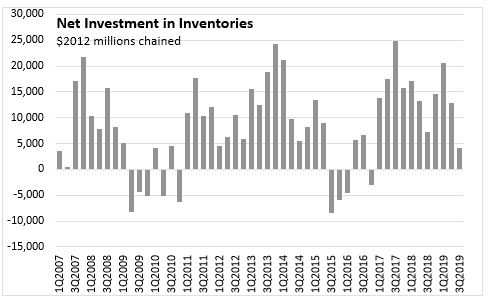
Export prices declined in Q3 due to a decline in crude oil and bitumen export prices, resulting in decline in the terms of trade (ratio of price of exports to price imports) that offset the gain the previous quarter. The GDP implicitly price index, which reflects overall price of domestically produced goods and services, was up 0.4 per cent.
Nominal GDP increased 1.6 per cent in Q3. Annualized compensation of employees rose 5.2 per cent led by service-producing industries. The household savings rate has risen from 1.3 per cent in Q3 2018 to 3.2 per cent in Q3 2019. Net operating surplus of corporation declined 18.9 per cent after increasing 36.0 per cent in Q2.
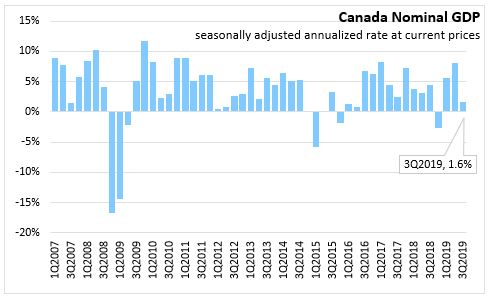

Source: Statistics Canada Tables 36-10-0103-01 and 36-10-0104-01
<--- Return to Archive